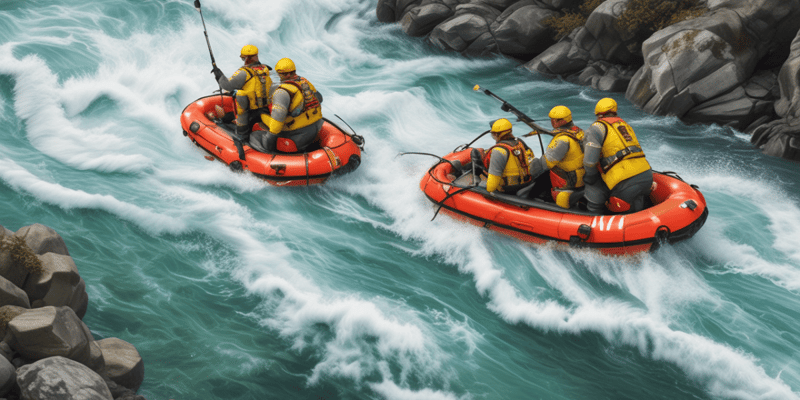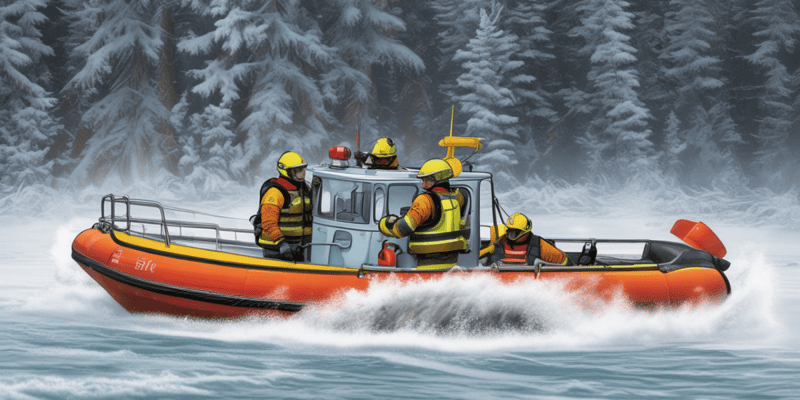Podcast
Questions and Answers
What is the primary responsibility of a Spotter in water rescue operations?
What is the primary responsibility of a Spotter in water rescue operations?
Which of the following items is NOT listed as required equipment for Level I Basic Swimmers?
Which of the following items is NOT listed as required equipment for Level I Basic Swimmers?
Which characteristic is essential for Spotters to maintain a clear line-of-sight with deployed swimmers?
Which characteristic is essential for Spotters to maintain a clear line-of-sight with deployed swimmers?
What additional equipment is required for Level I Rescue Swimmers compared to Level I Basic Swimmers?
What additional equipment is required for Level I Rescue Swimmers compared to Level I Basic Swimmers?
Signup and view all the answers
What role do Shore Support personnel play in water rescue operations?
What role do Shore Support personnel play in water rescue operations?
Signup and view all the answers
Which one of the following is NOT listed as water rescue equipment available at specified Fire Rescue Stations?
Which one of the following is NOT listed as water rescue equipment available at specified Fire Rescue Stations?
Signup and view all the answers
Which of the following is the correct placement for Spotters to maintain oversight during water rescues?
Which of the following is the correct placement for Spotters to maintain oversight during water rescues?
Signup and view all the answers
Which of the following must Level I Basic Swimmers avoid wearing during water rescues?
Which of the following must Level I Basic Swimmers avoid wearing during water rescues?
Signup and view all the answers
What is the required ratio of Spotters to swimmers during a water rescue operation?
What is the required ratio of Spotters to swimmers during a water rescue operation?
Signup and view all the answers
In which situation is the Fire Rescue personnel likely to decide on Recovery Mode?
In which situation is the Fire Rescue personnel likely to decide on Recovery Mode?
Signup and view all the answers
What factors should be assessed by arriving companies during a risk/benefit analysis?
What factors should be assessed by arriving companies during a risk/benefit analysis?
Signup and view all the answers
When might responding units or the Communication Center request a Dive Team response?
When might responding units or the Communication Center request a Dive Team response?
Signup and view all the answers
Who is responsible for assigning additional Accountability Officers at a rescue scene?
Who is responsible for assigning additional Accountability Officers at a rescue scene?
Signup and view all the answers
What primarily determines whether the emergency is classified as Rescue or Recovery Mode?
What primarily determines whether the emergency is classified as Rescue or Recovery Mode?
Signup and view all the answers
What should be taken into account to operate in Rescue Mode?
What should be taken into account to operate in Rescue Mode?
Signup and view all the answers
What may influence the decision to send Fire Rescue personnel into the water?
What may influence the decision to send Fire Rescue personnel into the water?
Signup and view all the answers
What constitutes a dive operation during open water rescues?
What constitutes a dive operation during open water rescues?
Signup and view all the answers
Which equipment is suggested for swimmers in open water rescues?
Which equipment is suggested for swimmers in open water rescues?
Signup and view all the answers
What is the recommended first step in the action plan for water rescue operations?
What is the recommended first step in the action plan for water rescue operations?
Signup and view all the answers
During an open water rescue, if conditions permit, what should the rescuer ideally do first?
During an open water rescue, if conditions permit, what should the rescuer ideally do first?
Signup and view all the answers
How many swimmers are required for the extraction of victims to safety?
How many swimmers are required for the extraction of victims to safety?
Signup and view all the answers
What should be done if a boat-based operation is needed in an open water rescue?
What should be done if a boat-based operation is needed in an open water rescue?
Signup and view all the answers
What item is NOT recommended to be used initially in a low-risk water rescue operation?
What item is NOT recommended to be used initially in a low-risk water rescue operation?
Signup and view all the answers
What must both the primary and backup swimmers possess for effective open water rescue?
What must both the primary and backup swimmers possess for effective open water rescue?
Signup and view all the answers
What is the minimum personnel requirement for a rescue operation?
What is the minimum personnel requirement for a rescue operation?
Signup and view all the answers
In which scenario can a swimmer be deployed for a rescue?
In which scenario can a swimmer be deployed for a rescue?
Signup and view all the answers
What is the purpose of establishing a 'Last-Seen-Point' during a water rescue?
What is the purpose of establishing a 'Last-Seen-Point' during a water rescue?
Signup and view all the answers
What should be done with witnesses during the scene size-up process?
What should be done with witnesses during the scene size-up process?
Signup and view all the answers
Which of the following is NOT a recommended method to gather information from witnesses?
Which of the following is NOT a recommended method to gather information from witnesses?
Signup and view all the answers
How should first arriving units prioritize gathering information?
How should first arriving units prioritize gathering information?
Signup and view all the answers
What is Recovery Mode primarily focused on?
What is Recovery Mode primarily focused on?
Signup and view all the answers
What is critical to do when there are witnesses to a water rescue incident?
What is critical to do when there are witnesses to a water rescue incident?
Signup and view all the answers
What is the primary purpose of marking the Last-Seen-Point with a pelican float?
What is the primary purpose of marking the Last-Seen-Point with a pelican float?
Signup and view all the answers
Which of the following is NOT a required action while operating in a navigable waterway during a rescue?
Which of the following is NOT a required action while operating in a navigable waterway during a rescue?
Signup and view all the answers
What is a recommendation for swimmers concerning entry and exit to the water?
What is a recommendation for swimmers concerning entry and exit to the water?
Signup and view all the answers
To which personnel category do all individuals entering the work area belong?
To which personnel category do all individuals entering the work area belong?
Signup and view all the answers
How many swimmers are required at a minimum for each victim during a rescue operation?
How many swimmers are required at a minimum for each victim during a rescue operation?
Signup and view all the answers
Which factor should NOT be part of the information collected about a victim?
Which factor should NOT be part of the information collected about a victim?
Signup and view all the answers
In what situation is it particularly important to have sufficient lighting during a rescue operation?
In what situation is it particularly important to have sufficient lighting during a rescue operation?
Signup and view all the answers
What should be done prior to deploying a swimmer to the water, when possible?
What should be done prior to deploying a swimmer to the water, when possible?
Signup and view all the answers
Study Notes
Personnel Roles and Responsibilities
- Spotter: Designated Fire Rescue personnel accountable for each deployed swimmer.
- Shore Support Personnel: Assigned to non-water activities like medical, transport, and decontamination.
- Victim: An individual in need of rescue.
Equipment Requirements
-
Personal Flotation Device (PFD): Mandatory for Shore Support personnel with emergency inflation feature.
-
Spotter Equipment:
- Elevated position for clear line-of-sight.
- Reflective vest for visibility.
- Binoculars for distance observation.
-
Level I Basic Swimmer Equipment:
- Swim attire (no long pants).
- Red flotation device (rescue buoy).
- Long blade fins.
-
Level I Rescue Swimmer Equipment:
- All Basic Swimmer gear, additionally includes:
- Water rescue rope.
- Water rescue paddle board.
- Short blade fins.
- All Basic Swimmer gear, additionally includes:
-
Additional Water Rescue Equipment: Available at specific Fire Rescue Stations includes:
- Water rescue paddle boards, ropes, short blade fins, board shorts, dive lights, portable air horns, flare guns, binoculars, marker flags.
Incident Management and Accountability
- Refer to 200 Series SOGs for Incident Management System and Accountability.
-
Accountability Structure:
- Assign Accountability Officer for incidents with two or more swimmers.
- Maintain a one-to-one ratio of Spotters to swimmers.
Risk Assessment
- Scene Assessment: Check for hazards like weather conditions, currents, and swimmer capabilities.
- Requests for Dive Team may occur based on initial scene assessment or delays in response.
- Decision to deploy personnel into water based on victim rescue viability and associated risks.
Operational Modes
- Rescue Mode: Effective within one hour of submersion indicating a possibility to save a life.
- Recovery Mode: Handed over to Law Enforcement once rescue chances diminish, prioritizing body recovery over life-saving.
Scene Size-Up Procedures
- Gather witness and bystander information to assess incident specifics.
- For victims above water, ascertain number and recommend additional resources if needed.
- For submerged victims, establish a "Last-Seen-Point" to streamline search and rescue efforts, interview witnesses for accurate location details.
Safety Considerations
- Deploy dive flags and proper lighting during operations to alert vessels.
- Limit the work area to essential personnel and establish a safe point of entry and exit for swimmers.
- Use visual hand signals before swimmer deployment for effective communication.
Resource Allocation
- Ensure a minimum staffing ratio:
- One primary swimmer per victim.
- One backup swimmer per primary.
- One spotter for each primary swimmer.
- Medical and Incident Safety Officers present.
Open Water Rescue Guidelines
- Avoid below-surface dives unless victim submersion is witnessed.
- Engage both primary and backup swimmers with matching capabilities and equipment for open water scenarios.
- Follow a step-by-step rescue action plan focusing on:
- Talk: Encourage victims to self-rescue.
- Reach: Utilize equipment to reach victims.
- Throw: Attempt to throw rescue aids.
- Row: Consider boat assistance if necessary.
- Go: Deploy swimmer for direct rescue, stabilizing with paddle boards and flotation devices before extraction.
Studying That Suits You
Use AI to generate personalized quizzes and flashcards to suit your learning preferences.
Related Documents
Description
This quiz covers the roles and responsibilities of Fire Rescue personnel during water rescue operations as outlined in SOG 330-02. It emphasizes the importance of designated spotters, shore support, and proper preparation for daily assignments. Test your knowledge on water rescue protocols and ensure readiness for emergency situations.




